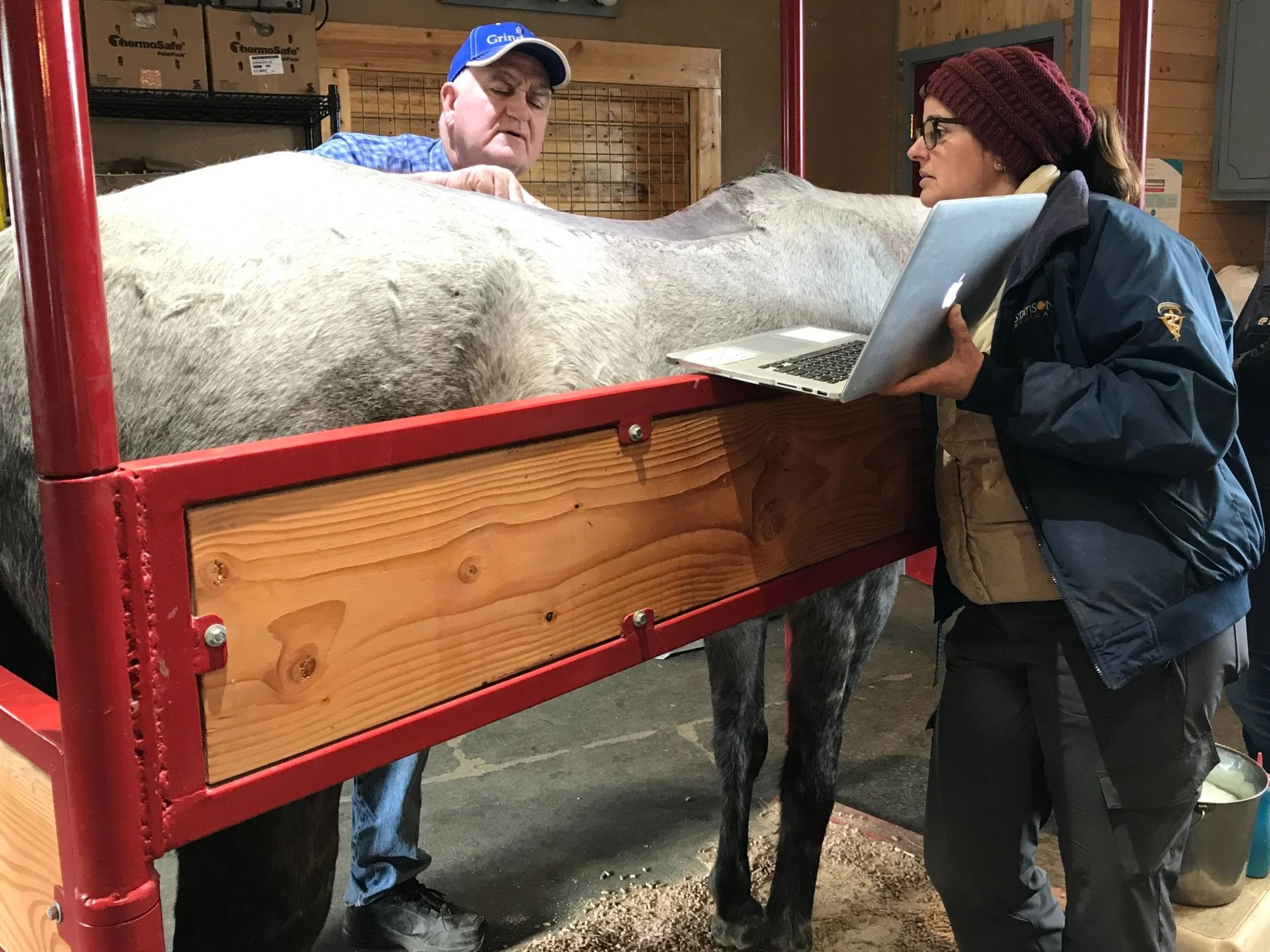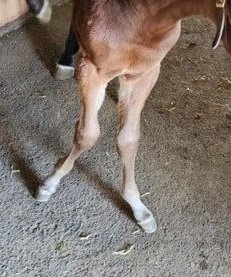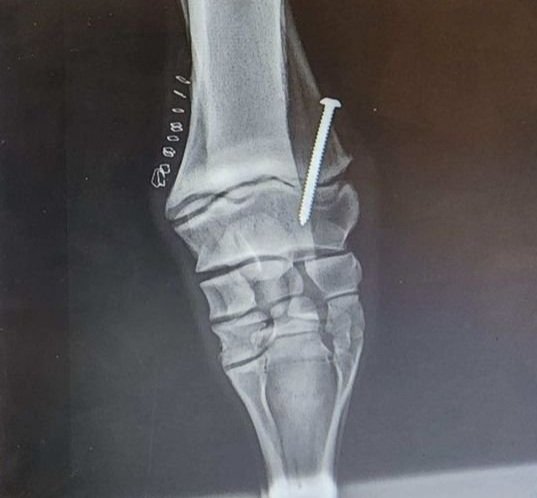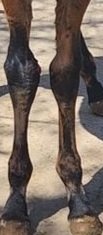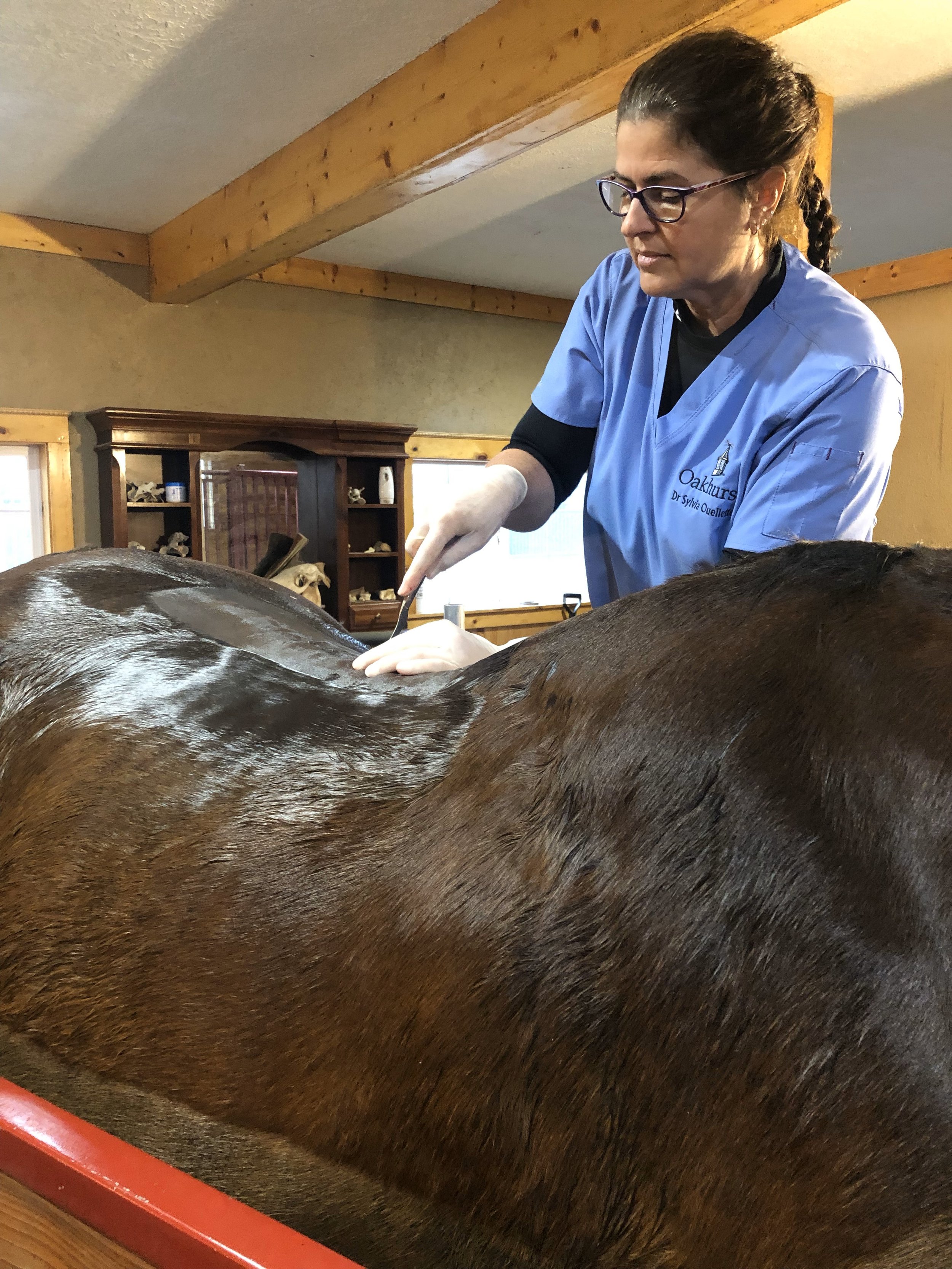
Equine Surgery
Equine Surgery
Presently at Oakhurst Equine in Newberg, Oregon, we provide a range of surgeries, which can be performed either in a stall setting using intravenous general anesthesia or in a standing position. If you think you may have a surgical case, please call us at 503-554-0227 or email office@oakhurstequine.com to arrange an appointment with one of our equine veterinarians for consultation and an estimate. Kindly note that at present, we do not offer colic surgeries or arthroscopies. Here is a partial list of some examples of the surgeries we can help you with.
Equine Castration
Routine castration and cryptorchidism are two different conditions related to the reproductive organs of horses. Let's explore each one:
Routine Castration: Routine castration, also known as gelding, is the surgical removal of the testicles in male horses. It is a common procedure performed to render a male horse (stallion or colt) sterile and eliminate behaviors associated with sexual maturity, such as aggression, mounting, and distraction due to mares in heat. Castrated horses, called geldings, are typically more manageable and easier to train.
The castration procedure involves making incisions in the scrotum to remove the testicles. It can be done under general anesthesia or standing sedation, depending on the veterinarian's preference and the horse's condition. Gelding is often performed on healthy horses, usually between the ages of 6 months and 3 years, although it can be done at any age.
Cryptorchidism: Cryptorchidism is a condition in which one or both testicles fail to descend into the scrotum. In horses, it is more commonly seen as a genetic trait, and affected horses are called "rigs" or "ridglings." Unlike routine castration, cryptorchidism requires additional considerations and sometimes more complex surgery.
In a cryptorchid horse, one or both testicles remain within the abdominal cavity or in the inguinal canal instead of descending into the scrotum. This condition can cause various problems, including reduced fertility and an increased risk of testicular cancer. If left untreated, cryptorchidism can also contribute to behavioral issues.
Surgical intervention is typically required to address cryptorchidism. The procedure, known as cryptorchidectomy, entails a meticulous exploration of either the abdomen or inguinal canal to locate and extract the undescended testicle(s). Compared to routine castration, cryptorchidectomy is a more intricate surgery that demands extensive expertise and experience. At Oakhurst, we are fortunate to have Dr. Jack Root, a highly experienced professional with years of expertise, performing our cryptorchid castrations. His skill and proficiency ensure the best possible outcome for our patients.
It's important to note that both routine castration and cryptorchidectomy should be performed by a skilled veterinarian to ensure the safety and well-being of the horse. If you suspect your horse may have cryptorchidism or if you're considering routine castration, consult with one of our experienced veterinarians for a proper evaluation and guidance specific to your horse's situation.
Interspinous Ligament Desmotomy (or Kissing Spine Surgery)
This minimally invasive standing surgery combines sedation and local anesthesia to effectively treat kissing spines. The procedure involves transecting the interspinous ligament between the dorsal spinous processes of the thoracic and/or lumbar spine. By creating space, this technique prevents the spinous processes from impinging upon each other. Notably, Dr. Jack Root has developed specialized surgical tools that have significantly facilitated the transection process, making the overall procedure more accessible and streamlined. Dr. Root performs Kissing Spine Surgery here at Oakhurst.
Kissing spine, also known as dorsal spinous process impingement (DSPI), is a condition that affects horses. It occurs when the spinous processes (bony projections) of the vertebrae in the horse's back come into contact with or "kiss" each other, causing pain and discomfort.
Kissing spine surgery is one of the treatment options for this condition. It involves removing or modifying the affected spinous processes to alleviate the pain and restore normal function. Here is an overview of the procedure:
Diagnosis: Before considering surgery, a veterinarian will evaluate the horse through a physical examination, including palpation and flexion tests, as well as diagnostic imaging such as X-rays or ultrasound. These tests help identify the location and severity of the kissing spine.
Pre-operative preparation: Once the diagnosis is confirmed, the horse will undergo a pre-operative evaluation to ensure it is healthy enough for surgery. This may include bloodwork, imaging, and other tests as deemed necessary by the veterinarian.
Surgical procedure: The surgical technique used to address kissing spine can vary depending on the specific case and the veterinarian's preference. There are a few different approaches, including:
a. Surgical resection: This involves removing the affected spinous processes. The veterinarian will make an incision along the horse's back, exposing the affected area. Using specialized instruments, the surgeon will carefully remove or modify the affected spinous processes, aiming to create more space between them to alleviate impingement.
b. Modified techniques: Some surgeons may choose to modify the spinous processes rather than removing them completely. This can involve shaving or trimming the processes to reduce their size and prevent further impingement.
Post-operative care: After the surgery, the horse will need a period of recovery and rehabilitation. This may involve stall rest, controlled exercise, and a gradual return to work. The veterinarian will provide specific instructions tailored to the individual horse's needs.
It's important to note that kissing spine surgery is not always necessary and is typically considered after conservative treatments, such as rest, anti-inflammatory medications, and physiotherapy, have been unsuccessful.
Kissing spine surgery in horses can alleviate pain, improve range of motion, and enhance performance by addressing the underlying issues associated with the condition.
As with any surgical procedure, there are risks involve such as post-operative complications such as infection or poor wound healing. It's crucial to have a thorough discussion with your veterinarian about the potential risks and benefits of surgery for your horse's specific condition.
Soft Tissue Surgery
Oakhurst veterinarians specialize in a wide range of soft tissue surgeries aimed at addressing tendon and ligament injuries with utmost precision and care. Our expertise includes procedures like plantar fascial transection and neurectomy, which effectively treat proximal suspensory desmitis in the hind limbs. We also offer inferior check ligament desmotomies to alleviate contracted tendons and club feet. And for cases of severe laminitis, we can perform deep digital flexor tendon tenotomies, ensuring optimal relief and improved outcomes for our patients.
Neurectomy
Neurectomy, specifically palmar digital neurectomy or plantar digital neurectomy, is a surgical procedure performed on horses with chronic navicular disease. Navicular disease is a condition that affects the navicular bone and associated structures in the foot, causing pain and lameness.
Consult with one of our experienced veterinarians to discuss the suitability of neurectomy for a particular horse, as well as the potential risks, benefits, and long-term implications associated with the procedure. It’s important to note that neurectomy is considered a last resort for horses with severe navicular disease that has not been controlled with medical treatment and/or therapeutic shoeing.
Osteomyelitis surgery
Osteomyelitis surgery is a crucial procedure aimed at debriding and treating infected or diseased bone, whether it occurs in a limb or the foot of a horse. Osteomyelitis is a severe condition characterized by the inflammation and infection of bone tissue, often resulting from bacteria entering the bone through an open wound or during a surgery. Surgical intervention becomes necessary when antibiotics alone cannot effectively eliminate the infection or when there is extensive damage to the bone. During the procedure, the experienced veterinarian carefully removes the necrotic or infected bone, by meticulous debridement of the affected area, aiming to preserve as much healthy bone as possible, to promote healing and restore structural integrity. The goal of osteomyelitis surgery is to eradicate the infection, relieve pain, and facilitate the horse's rehabilitation and return to normal function.
Periosteal Stripping
Periosteal stripping and growth plate bridging are two medical terms related to the treatment of orthopedic conditions in foals.
Periosteal Stripping: The periosteum is a thin layer of tissue that covers the outer surface of bones. Periosteal stripping involves the removal or separation of this tissue from the underlying bone. In foals, periosteal stripping is sometimes performed as a surgical procedure to address angular limb deformities.
Angular limb deformities occur when the long bones of the legs grow unevenly, resulting in abnormal limb alignment. Periosteal stripping aims to stimulate the growth of bone in the slower-growing side, allowing the affected limb to straighten and align properly. By removing or disrupting the periosteum, it triggers a healing response in the bone, stimulating bone growth in the desired direction.
Growth Plate Bridging: Growth plates, also known as epiphyseal plates, are cartilage regions located at the ends of long bones in young animals. They are responsible for the longitudinal growth of bones until they close and become solid bone. Growth plate bridging involves the intentional inhibition of the longer side of the growth plates.
In some cases, foals may develop growth plate abnormalities or injuries that interfere with normal growth and limb development. By bridging or fusing the growth plates surgically, the abnormal growth can be stopped, allowing the foal's limb to stabilize and develop more normally. Growth plate bridging is typically considered when other treatment options have been unsuccessful, and the abnormal growth poses a significant risk to the foal's health or quality of life.
It is important to note that both periosteal stripping and growth plate bridging are surgical procedures that should be performed by experienced veterinarians. The decision to proceed with these treatments is based on a thorough evaluation of the foal's condition and consultation with a veterinarian that has accumulated knowledge on this subject. Dr. Jack Root, with his extensive experience derived from his background in breeding and racing athletic foals, has been skillfully performing periosteal stripping procedures for many years.
Enucleation of the Eye
The surgical procedure to remove an eye from a horse is commonly referred to as "enucleation." Enucleation involves the removal of the entire eyeball and associated structures. It is typically performed as a last resort in cases of severe injury, infection, end-stage uveitis, cancer, or other medical conditions that cannot be treated effectively using a different method. The procedure is performed by one of our experienced veterinarians utilizing standing sedation or general anesthesia.
After enucleation, horses typically recover well with appropriate postoperative care. Horses can adapt well to the loss of an eye and usually resume their normal activities without significant limitations.

